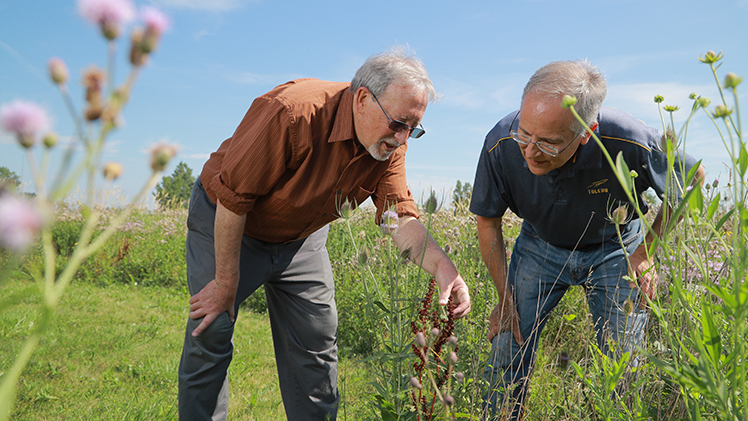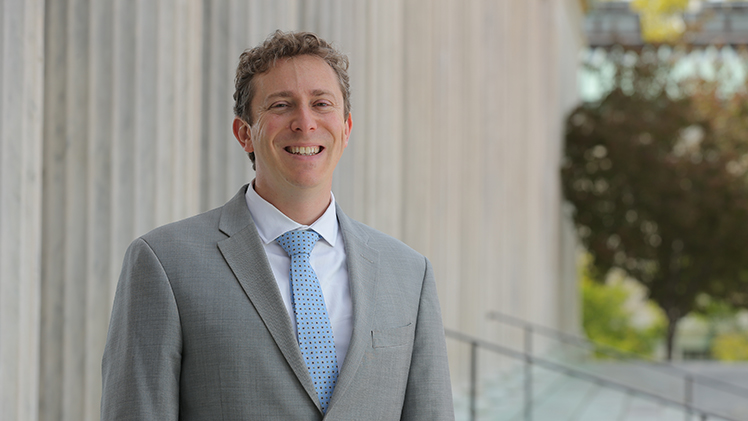The Power To Do Public Impact Research: Since a harmful algal bloom forced the city of Toledo to issue a “Do Not Drink” water advisory in 2014, UToledo has been working to protect water quality and the health of Lake Erie for the half million people in the region who depend on it for drinking water. This is the fifth in a five-part series detailing UToledo’s water quality research efforts over the past decade.
Ohio officials agree that wetlands are a valuable tool in the protection of western Lake Erie.

Dr. Daryl Dwyer, left, an associate professor in the Department of Environmental Sciences, and Dr. Kevin Czajkowski, a Distinguished University Professor in the Department of Geography and Planning, are among the UToledo researchers advancing land management strategies to prevent harmful algal blooms.
Their dense vegetation slows surface water runoff, trapping nitrogen, phosphorus, potassium and other nutrients that would otherwise feed harmful algal blooms like the one that settled around the raw water intake just outside Maumee Bay in 2014, releasing toxins and kicking off a three-day drinking water crisis for the half-million people who live in and around Toledo.
But where should those wetlands be positioned? And how should they be constructed?
These are some of the questions that researchers are exploring at The University of Toledo, drawing on areas of expertise that range from remote sensing technologies to the environmental applications of geophysics. Under the Ohio Department of Higher Education’s Harmful Algal Bloom Research Initiative and H2Ohio, the state’s comprehensive water quality initiative, they’re advancing land management strategies to prevent harmful algal blooms.
Meanwhile the College of Law’s Legal Institute of the Great Lakes has long supported discussions of the policies surrounding harmful algal bloom mitigation, among other legal, economic and social issues of importance to Great Lakes region of the United States and Canada.
“The water crisis was a wakeup call, and we’ve seen an impressive amount of progress in how we manage harmful algal blooms and how we understand the health effects of exposure since 2014,” said Dr. Daryl Dwyer, an associate professor in the Department of Environmental Sciences. “But it’s important that we look to the root of this issue. If we can lessen the occurrence or even prevent blooms altogether, then we may not have to worry about the rest.”
Shaping policy
Harmful algal bloom research preceded the crisis at UToledo’s Legal Institute of the Great Lakes.
The multidisciplinary center supports research, maintains publications and sponsors conferences — including its annual Great Lakes Water Conferences — on a wide range of issues related to water management. Harmful algal blooms were the issue at focus in a white paper and two subsequent workshops in 2012 and in an annual conference in 2013, and the issue has remained at the fore in subsequent years.
Ken Kilbert, professor emeritus of law and director of the Legal Institute of the Great Lakes during and after the water crisis in 2014, was among the first members of UToledo’s Water Task Force.
“The Legal Institute of the Great Lakes recognized, even prior to the Toledo water crisis, that law needed to be part of the solution to the harmful algal bloom problem,” he said. “Institute representatives have been explaining the complex web of existing laws applicable to key sources of nutrients causing harmful algal blooms, highlighting the shortcomings of existing laws and making recommendations on how to improve those laws to reduce blooms. The Legal Institute of the Great Lakes also has convened conferences, including its annual Great Lakes Water Conferences, that bring together leading experts in science, law, policy and other disciplines to educate the public and collaboratively work on solving the harmful algal blooms problem.”

Evan Zoldan, a professor in the College of Law, is director of the Legal Institute of the Great Lakes, the multidisciplinary center that supports research, maintains publications and sponsors conferences on issues of importance to the Great Lakes region of the United States and Canada.
The Legal Institute of the Great Lakes is active today under Evan Zoldan, a professor in the College of Law, and is set to offer a student fellowship for the first time this year. The fellow will be tasked with researching legal and policy questions of interest to the region.
November’s Great Lakes Water Conference is slated to focus on climate migration and the Great Lakes, with an eye toward exploring how climate events around the country will impact Toledo and the broader Great Lakes region.
Planning wetlands
Dr. Kevin Czajkowski, Distinguished University Professor of geography, is an expert in remote sensing technologies, having used high resolution satellite imagery, the state of Ohio’s lidar data and object image processing tools for more than 20 years to model agricultural fields in northwest Ohio. He and his student collaborators have also been driving rural roads in northwest Ohio for more than 15 years, observing from behind the windshield to develop a complementary cache of data that maps conservation practices in use across the region: Which farms plant cover crops, for example? Which are framed by narrow bands of vegetation called filter strips?
His data and expertise have proved valuable in collaborative efforts to prevent harmful algal blooms through land management, a cause he’s been championing since the earliest days of the water crisis and that’s picked up momentum since the launch of the state’s comprehensive water quality initiative, H2Ohio, in 2019.
H2Ohio zeroes in on several water quality issues in the state, ranging from harmful algal blooms to aging infrastructure. It encompasses land restoration and remediation as key elements toward the former, drawing on research proving that wetlands can be one of the most effective and cost-efficient ways to significantly improve water quality by preventing the flow of excess nutrients into waterways and lakes where they provide fuel for algal blooms.
UToledo researchers are lending their expertise to H2Ohio.
Dr. Thomas Bridgeman, professor of ecology and director of the UToledo Lake Erie Center, is leading a project to monitor sensor infrastructure and capacity at two wetlands: Magee Marsh Wildlife Area and the Ottawa National Wildlife Refuge. Meanwhile Dr. Kennedy Doro, associate professor in the Department of Environmental Sciences, brings his unique expertise in the environmental applications of geophysics to the H2Ohio Wetland Monitoring Program, in which he joins academics across the state in assessing the effectiveness and future role of implemented and planned wetland restoration projects under H2Ohio.
Czajkowski’s current projects are supported by the Harmful Algal Bloom Research Initiative. Working with collaborators at the Ohio State University, he’s been assessing the effectiveness of filter strips and other agricultural land management practices supported by H2Ohio. Working with collaborators at UToledo, he’s most recently using his own and other high-resolution data sets to target sites for restoration and nutrient interceptors in the Maumee Watershed.
Dwyer, a collaborator on the latter along with Dr. Kevin Egan, professor in the Department of Economics, is providing expertise on the ideal mode of restoration. A wetland requires a significant expanse of land, for example, but the much smaller “nutrient interceptor” needs a drop in elevation so that water flows through the cabinet-like instrument and the nutrient-adsorbing pellets inside.
“By investing in land management techniques, we’re looking ahead toward a future without harmful algal blooms,” Czajkowski said. “I’m feeling very optimistic about our collaborative efforts.”